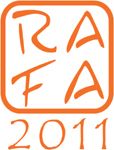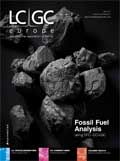Event News
Event News
The 5th International Symposium on Recent Advances in Food Analysis (RAFA 2011)
Conference organizers, the Institute of Chemical Technology in Prague, the Institute of Food Safety (RIKILT) in The Netherlands and the International Association of Environmental Analytical Chemistry (IAEAC), would like to invite all food scientists from universities, research institutes, national and international agencies, governmental and commercial laboratories, industry and other food business-related companies to attend the 5th International Symposium on Recent Advances in Food Analysis (RAFA) 2011 at the Clarion Congress Hotel Prague, Czech Republic, 1–4 November 2011.

Novel analytical applications in food research and a routine analysis are required to meet quality control (QC) and food safety criteria, comply with legal and labelling requirements, determine nutritional value and to detect food fraud/adul teration. It should be noted that, in spite of the legislative efforts, food scandals occasionally occur and can originate from contamination from pesticide residues, veterinary drug residues, endocrine disruptors, processing contaminants, migration from packaging materials or natural sources (including mycotoxins and marine toxins). Additionally, since modern biotechnology methods have been introduced to food production, GM food and food ingredients have become an issue and have led to a strong demand for adequate methods of analysis.
As a result the science of food analysis is a rapidly evolving and exciting field. In all cases, sampling strategy, sample analysis, data handling and final exposure assessment are crucial steps that are closely interrelated. The desired level of consumer protection and the strict regulation of maximum limits force analytical chemists in food laboratories to lower quantification limits, improve QA/QC and increase sample throughput by introducing new approaches and highly innovative technologies, including the use of bioassays for bioactivity and toxicity screening; omics-based analysis including metabolomics-like profiling; on-line and at-line analysis approaches; spectrometric food profiling (NMR, NIR); (bio)nanotechnology and chip-based methods; solvent-free and other emerging isolation technologies; and hyphenated techniques such as LC–MS and MS–MS, fast GC–TOF-MS, GC–MS–MS, ambient MS and/or comprehensive chromatography (GC?GC, LC?LC).
At the last RAFA conference in 2009, 530 scientists from 55 countries participated. Fifty seven oral communications (including 13 young scientists') and 440 posters were presented within the scientific programme. Ten vendor seminars and two satellite workshops were also organised. Scientific committee and organizers of the RAFA 2011 aim to prepare a balanced programme with high-quality presentations followed by stimulating discussions, several satellite events, a state-of-the-art exhibition and an attractive social programme.
Scientific contributions will be presented by leading scientists through key note lectures and contributed oral and poster presentations. Moreover, a platform for young scientists to present their scientific work will be offered. RAFA 2011 Student Travel Grants will be also provided. The best poster presentation(s) by a young scientist(s) will be awarded. Several satellite events are planned currently to accompany the conference programme.
An exhibition of the modern instruments used in food analysis will be on display during the symposium. Vendor seminars will be also organized to introduce recent instrumentation and scientific strategies for advanced food quality/safety control. Oral presentations can be submitted until 31 July 2011, poster presentations until 31 August 2011.
For further information contact Monika Tomaniova on +420 605 423 973, e-mail RAFA2011@vscht.cz or go to the website at www.rafa2011.eu
9–11 July 2011
Chirality 2011
Sherrington Building, University of Liverpool, UK
Tel: +44 151 795 0422
Fax: +44 151 795 5256
E-mail: chir2011@liv.ac.uk
Website: www.liv.ac.uk/chirality2011
20–22 July 2011
5th International Conference on Packed Column SFC (SFC 2011)
New York, New York, USA
Contact: Michelle Besanceney
Tel: +1 412 805 6296
E-mail: register@greenchemistrygroup.org
Website: www.greenchemistrygroup.org
7–11 August 2011
Microscopy & Microanalysis 2011
Nashville, Tennessee, USA
Organizer: Microscopy Society of America
Tel: +1 703 234 4115
Email: AssociationManagement@microscopy.org
Website: microscopy.org/MandM/2011
21–25 August 2011
Dixon 2011
Crowne Plaza, Brussels, Belgium
Tel: +32 2 739 3028
Fax: +32 2 743 1550
E-mail: dioxin2011@mci-group.com
Website: www.dioxon2011.org
5–9 September 2011
The 17th International Symposium on Separation Sciences (17-ISSS)
Hall of Grand Hotel Napoca,
Cluj-Napoca, Romania
Tel: +40 264 55 11 75
Fax: +40 264 55 11 75
E-mail: 17isss-secretariat@event-consulting.ro
Website: www.17issscluj2011.org
Send any event news to Doug Kitson at dkitson@advanstar.com
New TRC Facility Accelerates Innovation and Delivery
April 25th 2025We’ve expanded our capabilities with a state-of-the-art, 200,000 sq ft TRC facility in Toronto, completed in 2024 and staffed by over 100 PhD- and MSc-level scientists. This investment enables the development of more innovative compounds, a broader catalogue and custom offering, and streamlined operations for faster delivery. • Our extensive range of over 100,000 high-quality research chemicals—including APIs, metabolites, and impurities in both native and stable isotope-labelled forms—provides essential tools for uncovering molecular disease mechanisms and exploring new opportunities for therapeutic intervention.
New Guide: Characterising Impurity Standards – What Defines “Good Enough?”
April 25th 2025Impurity reference standards (IRSs) are essential for accurately identifying and quantifying impurities in pharmaceutical development and manufacturing. Yet, with limited regulatory guidance on how much characterisation is truly required for different applications, selecting the right standard can be challenging. To help, LGC has developed a new interactive multimedia guide, packed with expert insights to support your decision-making and give you greater confidence when choosing the right IRS for your specific needs.

.png&w=3840&q=75)

.png&w=3840&q=75)



.png&w=3840&q=75)



.png&w=3840&q=75)









